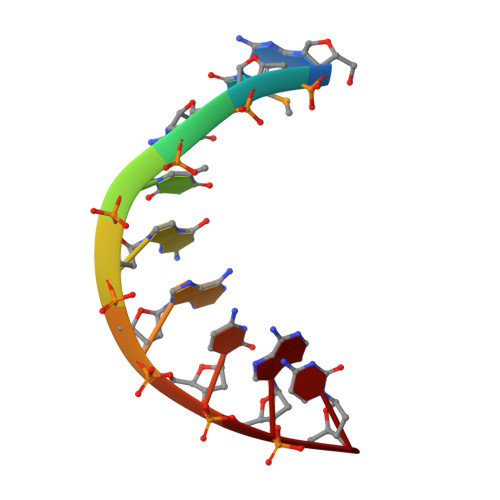Evolution of functional six-nucleotide DNA.
Zhang, L., Yang, Z., Sefah, K., Bradley, K.M., Hoshika, S., Kim, M.J., Kim, H.J., Zhu, G., Jimenez, E., Cansiz, S., Teng, I.T., Champanhac, C., McLendon, C., Liu, C., Zhang, W., Gerloff, D.L., Huang, Z., Tan, W., Benner, S.A.(2015) J Am Chem Soc 137: 6734-6737
- PubMed: 25966323
- DOI: https://doi.org/10.1021/jacs.5b02251
- Primary Citation of Related Structures:
4RHD - PubMed Abstract:
Axiomatically, the density of information stored in DNA, with just four nucleotides (GACT), is higher than in a binary code, but less than it might be if synthetic biologists succeed in adding independently replicating nucleotides to genetic systems. Such addition could also add functional groups not found in natural DNA, but useful for molecular performance. Here, we consider two new nucleotides (Z and P, 6-amino-5-nitro-3-(1'-β-D-2'-deoxyribo-furanosyl)-2(1H)-pyridone and 2-amino-8-(1'-β-D-2'-deoxyribofuranosyl)-imidazo[1,2-a]-1,3,5-triazin-4(8H)-one). These are designed to pair via complete Watson-Crick geometry. These were added to a library of oligonucleotides used in a laboratory in vitro evolution (LIVE) experiment; the GACTZP library was challenged to deliver molecules that bind selectively to liver cancer cells, but not to untransformed liver cells. Unlike in classical in vitro selection, low levels of mutation allow this system to evolve to create binding molecules not necessarily present in the original library. Over a dozen binding species were recovered. The best had Z and/or P in their sequences. Several had multiple, nearby, and adjacent Zs and Ps. Only the weaker binders contained no Z or P at all. This suggests that this system explored much of the sequence space available to this genetic system and that GACTZP libraries are richer reservoirs of functionality than standard libraries.
Organizational Affiliation:
†Department of Chemistry, Department of Physiology and Functional Genomics, UF Health Cancer Center, UF Genetics Institute, University of Florida, Gainesville, Florida 32611, United States.
















